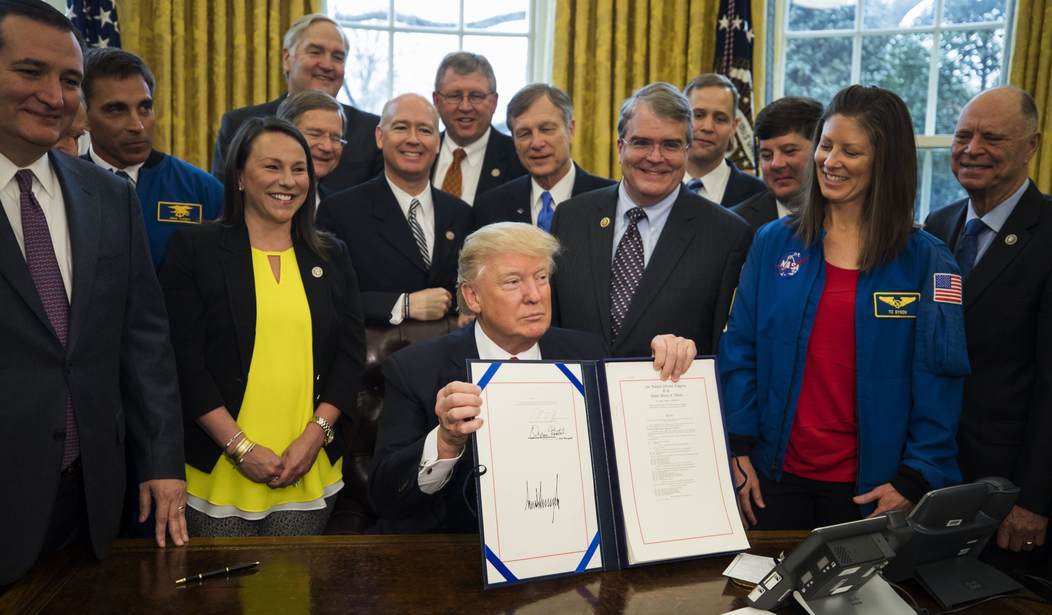WASHINGTON – Due to budget constraints NASA does not currently have the capability to land humans on the surface of Mars, NASA’s human exploration chief William H. Gerstenmaier said Wednesday, signaling that the Trump administration’s 2030s target date for the objective is highly ambitious.
“Through the 2030s, I can’t put a date on humans on Mars,” Gerstenmaier said during the American Institute for Aeronautics and Astronautics’ Propulsion and Energy Forum in Atlanta. “We don’t have the surface systems available for Mars, and entry-descent landing is a huge challenge for us, for Mars.”
President Trump in March signed the NASA Transition Authorization Act of 2017, a piece of legislation that envisions completing crewed missions either near or on the surface of Mars in the 2030s. Vice President Mike Pence during a tour of the Kennedy Space Center in Cape Canaveral, Fla., earlier this month said that the U.S. will put “American boots on the face of Mars,” though he didn’t offer an exact timeline.
Gerstenmaier, who started with NASA in 1977, described “fiscal realism” in discussing the agency’s requested $19.1 billion budget for 2018. He said that NASA does not anticipate any “big, huge” budget, but one that will be adjusted each year with standard, 2 percent increases for inflation.
Without a firm goal in surfacing Mars, Gerstenmaier was asked how the space agency can generate the type of excitement that America experienced during the Apollo program. His response was that NASA’s plans through the 2030s, which involve building a small space station in the vicinity of the moon and preparing for deep space transport, don’t need a firm destination.
“I actually see it as this resilient architecture that allows us to move in whatever direction we get told to move going forward, or if others want to contribute,” he said, suggesting the possibility for collaboration with private enterprises like SpaceX. The two sides are working together on SpaceX’s Red Dragon program, Elon Musk’s private mission that involves eventual plans for colonizing the Red Planet.
Gerstenmaier believes that for NASA, a Mars orbital mission in 2033 is realistic. The planned Mars missions will hinge on success of the agency’s Deep Space Gateway, which is NASA’s planned space station near the Moon. After construction of the space station, NASA will prepare for Deep Space Transport, which is expected to allow manned space travel outside the Earth-Moon system.
NASA’s Exploration Mission 2, or EM-2, is scheduled for launch in 2022. EM-2, a crewed mission aboard NASA’s Orion spacecraft, will be a weeks-long journey around the moon, in which NASA will deliver the first components for Deep Space Gateway. Six other exploration missions will follow in preparation for Deep Space Transport.
The Mars orbital mission, which will likely include a Venus flyby, is scheduled for 2033. Gerstenmaier said that Deep Space Gateway differs from the Apollo Program in that NASA has a broad objective in advancing human presence into deep space. The agency doesn’t have a single, defined objective like landing on the Moon, he said.
The rovers that have landed successfully on the Moon weigh about one metric ton each, but an unfueled ascent Mars vehicle, which would be required to surface the plant, would weigh about 20 metric tons. Mars reportedly has a thin atmosphere, making landing extremely difficult, especially for equipment that is 20 times heavier than what has previously landed.
“Without understanding how we want to do that, with supersonic retrorepulsion, it’s hard to put a date on that surface activity, but I think if we take these near-term milestones and we show how we can complete compelling missions with these near-term milestones, we can create that same excitement (as Apollo),” he said.









Join the conversation as a VIP Member